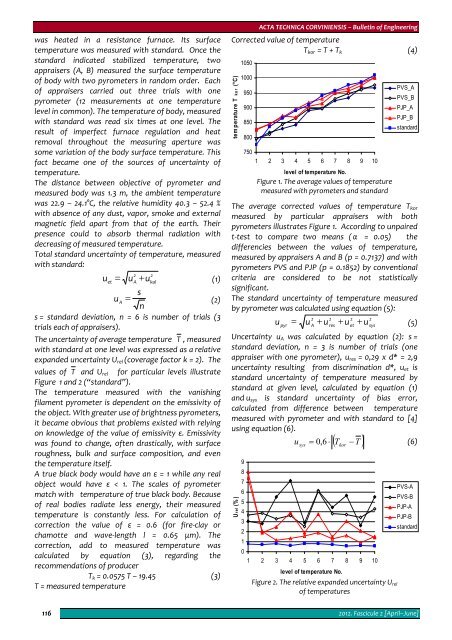Editorial & Advisory Board - Acta Technica Corviniensis
Editorial & Advisory Board - Acta Technica Corviniensis
Editorial & Advisory Board - Acta Technica Corviniensis
You also want an ePaper? Increase the reach of your titles
YUMPU automatically turns print PDFs into web optimized ePapers that Google loves.
was heated in a resistance furnace. Its surface<br />
temperature was measured with standard. Once the<br />
standard indicated stabilized temperature, two<br />
appraisers (A, B) measured the surface temperature<br />
of body with two pyrometers in random order. Each<br />
of appraisers carried out three trials with one<br />
pyrometer (12 measurements at one temperature<br />
level in common). The temperature of body, measured<br />
with standard was read six times at one level. The<br />
result of imperfect furnace regulation and heat<br />
removal throughout the measuring aperture was<br />
some variation of the body surface temperature. This<br />
fact became one of the sources of uncertainty of<br />
temperature.<br />
The distance between objective of pyrometer and<br />
measured body was 1.3 m, the ambient temperature<br />
was 22.9 – 24.1°C, the relative humidity 40.3 – 52.4 %<br />
with absence of any dust, vapor, smoke and external<br />
magnetic field apart from that of the earth. Their<br />
presence could to absorb thermal radiation with<br />
decreasing of measured temperature.<br />
Total standard uncertainty of temperature, measured<br />
with standard:<br />
2 2<br />
u<br />
et<br />
= uA<br />
+ ukal<br />
(1)<br />
s<br />
u A<br />
= (2)<br />
n<br />
s = standard deviation, n = 6 is number of trials (3<br />
trials each of appraisers).<br />
The uncertainty of average temperature T , measured<br />
with standard at one level was expressed as a relative<br />
expanded uncertainty U rel (coverage factor k = 2). The<br />
values of T and U rel for particular levels illustrate<br />
Figure 1 and 2 (“standard”).<br />
The temperature measured with the vanishing<br />
filament pyrometer is dependent on the emissivity of<br />
the object. With greater use of brightness pyrometers,<br />
it became obvious that problems existed with relying<br />
on knowledge of the value of emissivity ε. Emissivity<br />
was found to change, often drastically, with surface<br />
roughness, bulk and surface composition, and even<br />
the temperature itself.<br />
A true black body would have an ε = 1 while any real<br />
object would have ε < 1. The scales of pyrometer<br />
match with temperature of true black body. Because<br />
of real bodies radiate less energy, their measured<br />
temperature is constantly less. For calculation of<br />
correction the value of ε = 0.6 (for fire‐clay or<br />
chamotte and wave‐length l = 0.65 μm). The<br />
correction, add to measured temperature was<br />
calculated by equation (3), regarding the<br />
recommendations of producer<br />
T k = 0.0575 T – 19.45 (3)<br />
T = measured temperature<br />
ACTA TECHNICA CORVINIENSIS – Bulletin of Engineering<br />
Corrected value of temperature<br />
T kor = T + T k (4)<br />
temperature T kor (°C)<br />
1050<br />
1000<br />
950<br />
900<br />
850<br />
800<br />
750<br />
1 2 3 4 5 6 7 8 9 10<br />
level of temperature No.<br />
Figure 1. The average values of temperature<br />
measured with pyrometers and standard<br />
PVS_A<br />
PVS_B<br />
PJP_A<br />
PJP_B<br />
standard<br />
The average corrected values of temperature T kor<br />
measured by particular appraisers with both<br />
pyrometers illustrates Figure 1. According to unpaired<br />
t‐test to compare two means ( α = 0.05) the<br />
differencies between the values of temperature,<br />
measured by appraisers A and B (p = 0.7137) and with<br />
pyrometers PVS and PJP (p = 0.1852) by conventional<br />
criteria are considered to be not statistically<br />
significant.<br />
The standard uncertainty of temperature measured<br />
by pyrometer was calculated using equation (5):<br />
u = u + u + u + u (5)<br />
pyr<br />
2<br />
A<br />
Uncertainty u A was calculated by equation (2): s =<br />
standard deviation, n = 3 is number of trials (one<br />
appraiser with one pyrometer), u res = 0,29 x d* = 2,9<br />
uncertainty resulting from discrimination d*, u et is<br />
standard uncertainty of temperature measured by<br />
standard at given level, calculated by equation (1)<br />
and u sys is standard uncertainty of bias error,<br />
calculated from difference between temperature<br />
measured with pyrometer and with standard to [4]<br />
using equation (6).<br />
U rel (% )<br />
9<br />
8<br />
7<br />
6<br />
5<br />
4<br />
3<br />
2<br />
1<br />
0<br />
u<br />
sys<br />
= , 6 ⋅<br />
2<br />
res<br />
2<br />
et<br />
( T − T )<br />
kor<br />
2<br />
sys<br />
0 (6)<br />
1 2 3 4 5 6 7 8 9 10<br />
level of temperature No.<br />
Figure 2. The relative expanded uncertainty U rel<br />
of temperatures<br />
PVS-A<br />
PVS-B<br />
PJP-A<br />
PJP-B<br />
standard<br />
116<br />
2012. Fascicule 2 [April–June]

















